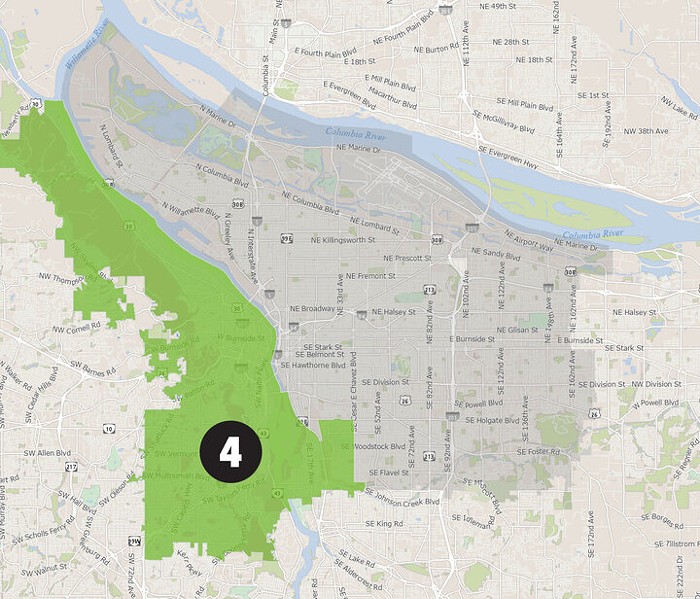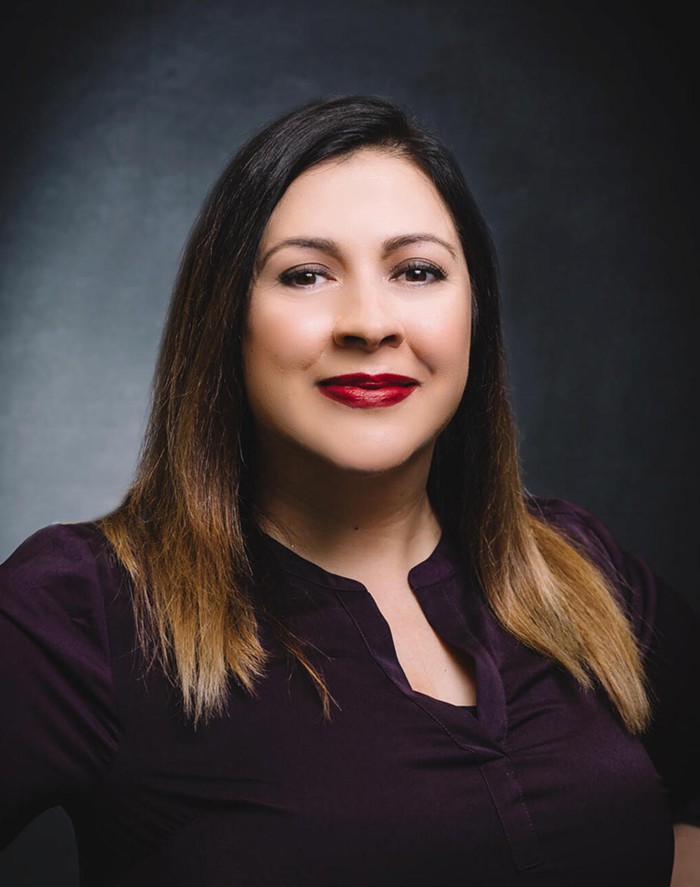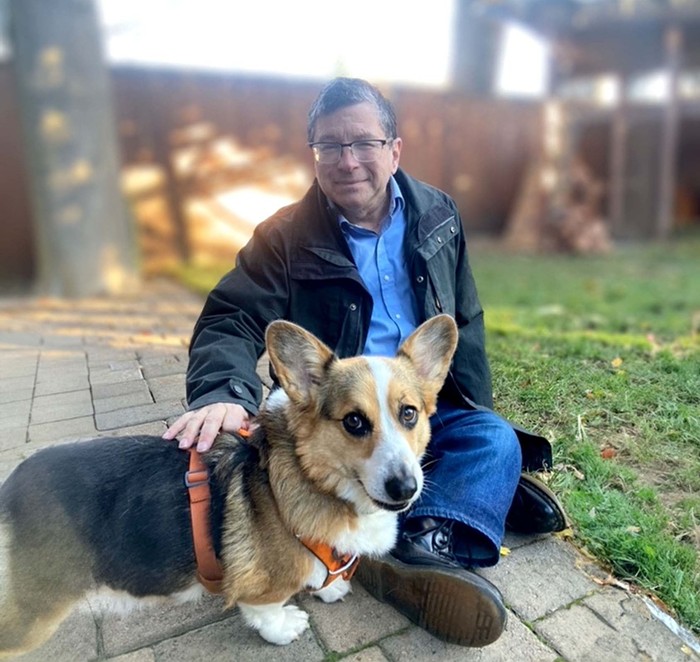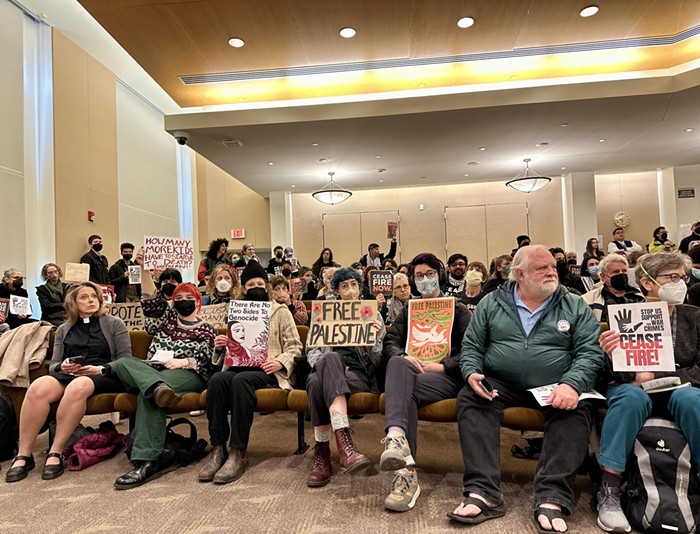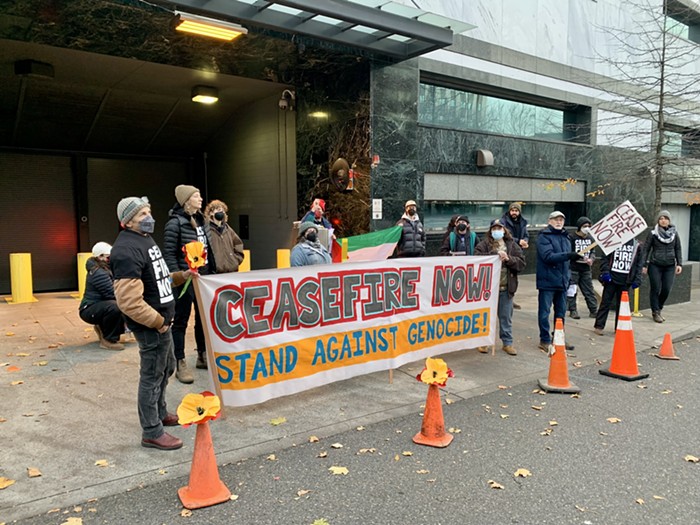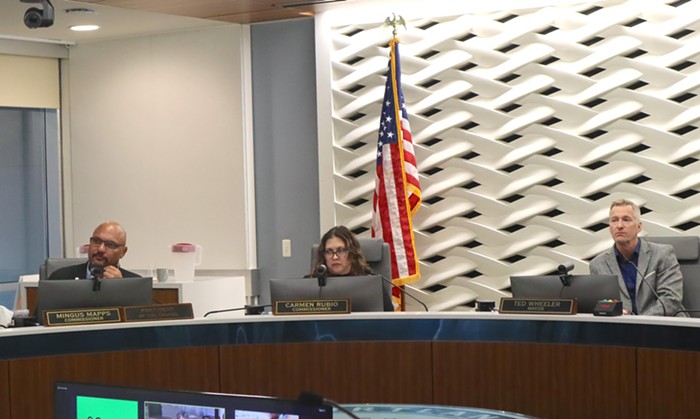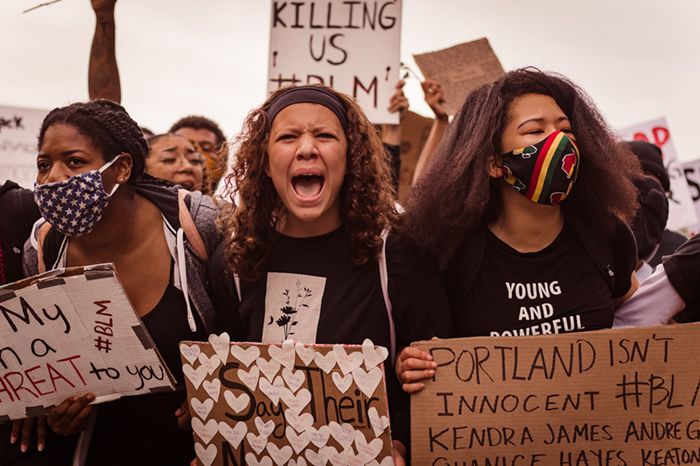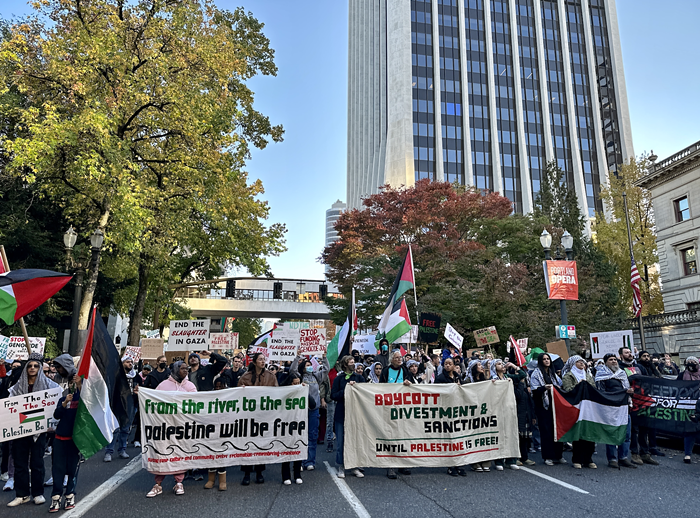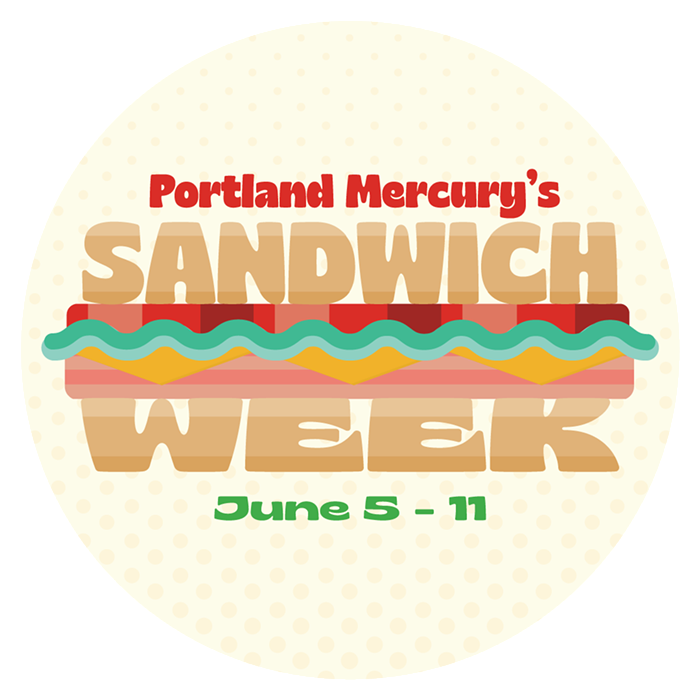6:28 pm update: It's unanimous. They all voted for it.
6:06 pm update: Time to discuss and vote, after the cut.
5:30 update: We've only got a few more folks on the public testimony list, then stay tuned for council deliberation and voting! That's all after the cut.
(Originally posted at 2 pm) With minutes--minutes!!--to go before this afternoon's hearing, the Oregon Department of Transportation letter is finally ready. Apparently it was a work in progress until this afternoon.
And even after all that work, I have to tell you, it's a weak letter. I'm hoping for an electronic copy I can post, but here are the skimpy highlights:
"The partnership, between the Oregon Department of Transportation and the City of Portland is as strong, or stronger, than at any time I know of," writes ODOT Director Matthew Garrett. "Together, ODOT, the City and other regional partners, have worked together to design and construct projects that will improve the transportation system consistent with the goals of the City of Portland."
That "vital partnership will continue to direct the course we will chart for the Columbia River Crossing project. While our federal charge as stewards of the Interstate System places both the Oregon and Washington Departments of Transportation as lead agencies for this critical project, let there be no misunderstanding: as this project transitions from the planning phase to the design/construction phase, the City of Portland's continued input, vision and counsel will be critical to delivering a project which improves the safety and efficiency of the Interstate, offers transportation choices, and represents the values and needs of the Portland citizenry....
The city's active participation in this forum is not only expected, but critical to advancing and delivering this much-needed project. Put simply, this approach which promotes honest, passionate and open debate is how this region has successfully delivered complex projects in the past. I am confident this process will ensure that we will secure the appropriate solutions for the Columbia River Crossing project."
Emphasis mine. Note the lack of strong language giving the city true oversight of the project, and the dance around what Portland wants, namely a reduction in vehicle miles traveled, and a study of greenhouse gas emissions related to the project. Those are, apparently, summed up as our "values and needs."
Stay tuned after the cut for more of the hearing. We've already got more than 60 people signed up to testify, and they've opened the upper balcony for the overflow crowd. (FYI: Our new blog software automatically saves what I'm liveblogging every minute or so, which is great for you... but please be patient if it saves something mid-sentence.)
Commissioner Sam Adams is opening the hearing, talking about the "antiquated" bridge. "I believe after the study of the work of the Columbia River task force, that we need a replacement. But it must be the right bridge in terms of design, construction, funding and operation."
"The new crossing must permanently reduce vehicle miles traveled... we need congestion priced electronic-based tolling... and new options like light rail..." while speeding freight along the corridor.
"This new bridge must be the result of new federal and state transportation funding," funding that won't compete with other local and regional requests. "This is absolutely essential, given that Portland has a $431 million transportation maintenance and safety backlog."
"This bridge must be an inspired, green, postcard worthy design" that's also sensitive to its neighbors and enhances the beauty of the Columbia River area.
"Portland is the nation's leading incubator of sustainable design," making us well prepared to work on the bridge.
"Portland's vote today is not the ultimate yes to approve this bridge," it will just move the bridge "from one evaluation phase to the next," and will start with the assumption in the next phase "that the existing bridge must be replaced, with no more through lanes" than there are now, and with light rail.
He's confident that "nothing will move forward over our strenuous objections," Adams says. "Although we don't have statutory veto power in this process... I do feel confident... that our concerns and our goals will be addressed to our satisfaction in the future. But I want to be crystal clear..." he will oppose the bridge if it doesn't.
Today's resolution "should not be construed" as the city's final acceptance of the project.
Now Fred Hansen from TriMet and ODOT's Matt Garrett are up.
"I completely subscribe to the comments of Commissioner Adams," Garrett says. It's taken a decade to get here, "and we are now at a point to take advantage of an opportunity... an opportunity to secure light rail" over the river. "An opportunity to secure a bridge that's much safer."
"There will be fewer cars traveling across this bridge than there would be if we did nothing," he says.
He's reiterating how healthy ODOT and the city's relationship is. "There are tangible examples of the relationship we have," he says, citing 82nd and the Mall 205 area, among others.
Calling this "a significant milestone," he says we have a long way to go. "But we will be at the table to answer those questions and find solutions." And they will "deliver a bridge that not only the city of Portland and the state of Oregon, but also the nation will be proud of."
Adams has a question: Would ODOT forward a bridge to the federal government with a request for funding, over the objection of a majority of the Portland city council? "No, that would be a failure of leadership," Garrett says. "We need to bring forward a solution that we all embrace."
Hansen is up: "Let me be precise in looking at it from my perspective," which is one of transit. "My view has been consistent. I believe that the existing three through lanes... are compromised," with no way to respond to a stall, for example. "Number two, I believe the lift span... is appropriate to be able to be replaced." And number three is light rail. "It in, in my view, absolutely critical."
The issues that are yet to be resolved are issues that he thinks are very important, like the number of auxiliary lanes, which cannot increase capacity. "Those decisions are ones that I think are critical."
"Let me just close my emphasizing two additional points... in terms of the construction of this project, we expect that the green practices in construction... those issues are and will be forefront and I believe tremendously important in the construction of this project." And all members of this community must "be able to participate" in constructing this project, including women-owned and minority-owned businesses.
Saltzman is asking Garrett about congestion based pricing. Garrett says that's something they'll be looking at as soon as possible. "If the higher gas prices we're seeing in the future," continue, and people drive less, and we see fewer gas tax revenues, "what's your response to that kind of a scenario?" Saltzman asks.
Garrett's talking about transponders, which was studied under a pilot program in Portland, perhaps taxing based on vehicle miles traveled (which would, in theory, encourage people to drive less and pay their fair share).
Potter is wondering what the financial plan. "It's seeming rather loose in how it would be paid for," he says. "Will there be a specific plan in place, with a specific revenue plan," that will be guaranteed before construction begins?
There has to be, Garrett says. "Once we secure the locally preferred alternative, it's in the time period between the draft and the final" environmental impact statement, that they sort out the financial details. "You have to have your financial plan in order," to build it, he says.
"The financial plan will be solid," Garrett concludes.
"And it's my understanding that the city of Portland will not be required to contribute," Potter asks.
"There's nothing before you today" asking for money, Garrett says.
"Will there be?" Potter asks, and the crowd chuckles.
Garrett's answer is evasive, mentioning something about the city putting forward money "to leverage additional opportunities..."
"We're not asking for anything now," Garrett says.
"The last time we met, you were going to provide me with some information on the decision points... where the decisions would be made, who would make them," etc, Potter asks.
"I have a timeline," says Garrett, which he's happy to give to the mayor.
"Could you give that to the council clerk?" Potter asks.
Adams wants to bring up "a couple of issues related to finance, to get them on the record," saying that "any effort to come up with state funding that preempts local governments' ability" to finance their own transportation projects, "I would oppose."
By the time the council would sign off on a final project, they'd know if the state was successful in finding statewide resources for this bridge, Adams adds.
Two more invited testimony people are up, Robert Liberty, Metro councilor, and Leslie Carlson of the Sustainable Development Commission--both of whom are critical of the project.
"I'm hear today speaking on my own behalf as a Metro councilor," Liberty says, noting that his views differ from his fellow councilors. He'll be talking about the bridge, "money, and power."
"I think there are many ways we can address the movement of goods, materials and services that are financially, socially and environmentally responsible. The project before you is not one of them," he says, adding that it's bad for the environment and our communities.
"Let me go over two points of factual information that might be useful for your consideration," he says. The structural soundness of the two bridges, for starters. One of the two bridges (which together make up the current crossing) is younger than three of the Willamette bridges. There are 30 bridges identified (I think he said by ODOT, in Oregon alone) along I-5 as "structurally deficient," and the current bridges aren't on that list. In fact, it's rated the same as the Marquam bridge.
Liberty--in glasses and a bowtie--is now citing technical documents about the drawbridge and the downstream rail bridge. He's talking about the "distribution of trips" by kind of vehicles on the river, and only 30 of those per year can't actually clear the bridge. It would be cheaper, Liberty quips, to buy those boat owners new boats for the other side of the bridge, "saving, perhaps, a couple of billion dollars."
The real issue is that boats have to make a tricky turn to get under both the rail bridge and the Interstate bridge, but that can be corrected for $45 million, Liberty says.
(Outside, the Oil Enforcement Agency brigade just fired up some LOUD music...)
Liberty's talking about money. The feds are only going to pony up $400-600 million. The states' share will be more than a billion. But he thinks the state's chances of passing a 14 cent gas tax are "rather low." So who will pay for it?
Now he's got a fact sheet from the feds' website on "money authorized for the entire country," and the CRC is not on the list. "We actually don't know what the federal contribution will be," he says. "No one really knows where the highway money will come from," especially with a new administration coming in.
"'Don't assume we can fund everything,'" is something Rep. Earl Blumenauer has said, Liberty relays.
Now, power. "I believe as a matter of practical politics... that by approving this resolution, Portland is ceding its power" to the state DOTs. Letters don't cut it, he says.
"Reject the resolution before you," he says. "Failing that, here are some options. Make your approval valid for one year," during which they can get more info on funding from the feds and state, plus impacts from greenhouse gas emissions, and data on vehicle miles traveled. "Travel has fallen on the bridge two years in a row now," he points out, so new studies are needed.
The second approach would be to make their approval contingent on a specific amount--say, $600 million--is the max the state will contribute to the project.
Liberty thinks the chances of this project actually materializing is less than 50-50. But do we have a plan B and plan C to address the issues at the crossing? Perhaps the city should be working on that, with a plan B of putting in transit and tolling, or a plan C for doing something "smarter, cheaper and greener."
This is a project with "1960 ideas with 2030 prices," he concludes.
Adams says he has considered Liberty's points and takes them very seriously. For him, the difference on this bridge is that it's a drawbridge. "I'm not satisfied will all of the evaluation that's been done to date," Adams says. "For me, there will have to be a drop dead date by which this bridge has to have the finances together or not."
"The notion of a plan B is a very useful notion," he says. "That's why I'm very interested in the early implementation of tolling" as an interim plan "while decisions are made about how to fund this particular plan."
Adams says they've looked at the conditional one-year approval, but it doesn't "clear federal muster."
"An approval today is not a yes to the project," but moves it to the next phase of study, Adams says.
"We've built our reputation on" an integrated approach to land use and transportation planning, Liberty points out, with choices of how to travel and choices of how to live. He fears this says "the most important thing is to draft" a policy that says we need a 12-lane freeway bridge, which is incongruent with our reputation.
Leslie Carlson's up. She's the co-chair of the Portland/Multnomah County Sustainable Development Commission, and a small business owner.
"I know you've read the commissions letter," so she won't repeat their criticisms, but she wants to add some info.
It's safe to say that "there's a paradigm shift going on" and in 20 to 25 years, the way we travel will be very different than it is now. Prices of things like gas are going up on a daily basis, vehicle miles traveled are going down, along with gas consumption, and transit is filling up. We're expecting a carbon tax in next year's legislature.
"Even if the cost of oil will drop, those taxes on carbon will mean oil will remain expensive into the future," she says. The CRC's data is based on $1.25 gas. "No allowances for a carbon tax" were built into the studies.
Portland has a great reputation for transportation and land use planning. "The SDC sees the CRC as an opportunity for a new model" for a transportation system that decreases vehicle miles traveled. But the plan they're voting on today increases vehicle miles traveled.
The SDC "strongly supports" additional modeling and data, they also support congestion based pricing, and tolling starting sooner than construction. "Sustainability needs to be at the core of the bridge... we need to take a good long look at what kind of bridge is built."
Saltzman is thanking Carlson and the rest of the SDC, saying "what's historic" about their consideration of this project is that they have an SDC to consult about it. (And, I might add, to then virtually ignore by approving the CRC proposal. But hey, we asked them first!)
Potter is calling Garrett back up, to address Liberty's statements about the city's authority on land use where it meets transportation. Garrett said a lot of technical stuff that seemed to satisfy Potter's concerns.
We've got SEVENTY NINE people signed up to testify. Potter's keeping testimony to two minutes each.
Edward Barnes is up first: He wants them to approve a crossing with light rail.
Craig Smith, who lives in Battle Ground, WA, doing something with finishing--he doesn't have the option to work where he lives. "We need to do something, for myself and the members of Local 555," he wants them to replace the bridge with light rail, "and if you could get in bike, that would be really nice."
Jim Howell acknowledges that the bridge is obsolete and probably should be replaced. "This bridge is a critical link in the I-5 corridor," he says, after laying out all of the functions of the bridge - then adding that he's talking about the railroad bridge just west of the Interstate bridge. He's arguing that "replacing the two track railroad bridge" built during Teddy Roosevelt's era should be a top priority, and "you'd basically eliminate all of the railroad lifts" on the Interstate bridge.
Lynn Lehrbach is here representing Teamsters. Guess what? He wants a new bridge. Otherwise, "how long would it take in the future to get back to this point again?"
Pia Welch is talking about cargo and FedEx. "In order to maintain our economic competitiveness," we need to get traffic moving. She and her allies support the new bridge. "The recommended bridge is a good step toward improving safety" and making pickups more reliable.
Jeff Swanson with Schnitzer Steel--who looks like a young Mormon guy on that mission thing--is talking about how "time matters" and the bridge congestion has a "direct impact" on our bottom line. And that cost is passed on to people who buy goods and services. "This project is long overdue and needs to move toward swift fulfillment."
Kathryn Williams, business affairs manager for the Port of Portland. The I-5 corridor is "the crossroads where all freight modes" converge. "The Port supports a replacement bridge" with light rail transit and improvements to the interchanges in the bridge area, that also models on our values as a region. "Thank you for your hard work and careful attention to this project," she concludes.
Mike Houck, associated with 1000 Friends of Oregon, Coalition for a Liveable Future, and the SDC, is bringing up the "climate smart" alternative. "You've heard very well thought out testimony earlier... the recommendations you've been receiving are far from knee-jerk alternatives," as he says the Oregonian called them a few days ago. "I believe the CRC decision represents an opportunity to move" the region to carbon reduction.
"I'm Chris Smith," Smith tells the council, saying he'll be talking about financial plan, which he says he has about as much confidence in as one "written on the back of a napkin." He's bringing up the massive backlog of transportation needs in Portland, plus projects like the Sellwood Bridge. What do they have in common? "They will compete" for motor vehicle taxes in the state. "I would also like to point out that significant portions of the funding for this bridge will be borrowed," he says, and then depend on people driving to pay the fees that will pay back the bonds. But if people drive less, "this is very financially risky."
Everyone's favorite curmudgeon, Terry Parker, is up. It's "discriminatory" to promote alternative modes of transportation and toll cars. And cyclists are "freeloading," he says. As for more lanes leading to sprawl, he says "hey, it's population growth." The council "can't legislate from a bubble."
Bill Scott, formerly of Flexcar, and now of Zipcar. "I'm hear to advocate that you take a step forward for addressing" the crossing "by rejecting this resolution. I don't believe you have a viable option in front of you." He was originally a "knee jerk supporter" of the project, but as he learned more about it, the more he realized he "needed to take a stand against it." He's "convinced that this bridge won't be built in its current format... it isn't needed to solve the problems at the crossing... its time to pull the plug."
Jill Fuglister of the Coalition for a Livable Future (CLF)--and one of only two no votes for this project on the task force--is up, urging the council to reject this alternative. Even as the region grows, it's important "that the amount we drive doesn't," but the proposal in front of the council now doesn't do that. "The more steps forward taken toward the 12 lane proposal, the harder it will be to switch direction." She adds that "it's unclear, and should be clarified, the decision making points ahead." She "understands it will be difficult" to reject this proposal. But trying to "right size" it later will be harder.
The CLF's policy director Mara Gross is up, and she's going to talk about "the impact the CRC is going to have on other" tranportation projects, like the Sellwood Bridge and Safe, Sound and Green Streets, and the Gray to Green stormwater project--the three add up to over $1 billion dollars in projects. How can we afford that and the CRC? She's citing Adams' Oregonian op-ed from this morning, which mentioned connecting the east and west halves of Hayden Island, which Gross says would cost another $100 million. "There's also the cost of what other expansions this project is going to necessitate," she says--such as in the Rose Quarter, which would be a "mega project." With "all of these problems and more" they urge the council to reconsider their support of the CRC.
(Adams clarifies that the costly Hayden Island issue she refers to is a north-south one, not the east-west one that's part of the CRC.)
Emily Hicks--also, I believe, involved with the CRC--is "here today to encourage you to listen to the experts in the room... and demand a clearer vision of what this project looks like before moving forward." Moving forward "without all the information" isn't the way Portland does things, she points out. "Shouldn't we be thinking of ways to be decreasing the numbers of single-occupancy cars instead of building room for more?" This is "an opportunity to really lead," she concludes.
Mel Rader with Upstream Public Health is talking about the health outcomes of the project, a study that was lead by the Multnomah County Health Department. "Some of the impacts... include air pollution [and] excessive noise," which will disproportionately impact low income people who live near the freeway. The proposal in front of the council today "is not good enough."
Bob Stacey, head of 1000 Friends of Oregon, follows up on that testimony by saying "these concerns compel a vote not to approve the LPA," but instead to require a supplementary DEIS that addresses the concerns of the city of Portland. "You should be concerned," that they don't have real agreement with the other jurisdictional partners in the project. "You don't have a happy family here. You should send a very clear signal here, that the dialogue begins with a no here" and a demand for a better design.
Adams jumps in. "It is possible that we could get what we are asking for. It is possible. We've had assurances that we're not going to get rolled," he says, repeating a few of Stacey's words. "The hope that I have, that is is possible, that we can have one of those transformational moments," stems from what was going on with this project several years ago, when the bridge was even bigger. "There was adamant opposition" that there would not be light rail. "In three and a half years, I've seen stakeholders' opinions change" on this project. "So I think your points are absolutely excellent, and if we couldn't shut this down in the future if we do get rolled, I wouldn't recommend moving forward... even though our leverage in the future is political, not statutory." Adams says he has a "glass is half full" view based on his experience of the last three and a half years.
This project "supports continued traffic growth," when what we should be doing is "reducing traffic growth," says Tom Buchele, I believe of Lewis and Clark. "The mega bridge goes in exactly the wrong direction."
Ben Rhiger is drawing the connections between this project and the never-built Mt. Hood Freeway. "I'm asking council to cautiously reject" this proposal before it gets out of control.
Commissioner Nick Fish has some specific questions. "Are you comfortable with the 'but' that we've arrived at," in a "yes, but" approval of the proposal, Fish asks Stacey.
"If it's fair to say we have some agreement of the 'but,'" is the "fundamental question" that the council will lose their leverage by voting yes, Fish asks Stacey. "Yes," Stacey says.
Greg Johnson is here representing ironworkers, and he's a member of the Columbia Pacific Building trades. "We're in need of a new bridge, and the price to build it will only be going up as time goes on... in four years you're going to pay $10 billion," he says.
Jay Coolman thinks opposing a bridge is "naive. You're going to have to build it one way or another," he says. Building it will funnel growth into Clark County and Vancouver, he says, which will require them to adopt growth management plans like this side of the river has. "If you guys don't force, essentially... we keep discussing this as if Vancouver is an equal partner," he says, but Vancouver has to "submit to the fact that they don't have the equal authority that we do." He wants the council to make sure we control growth. Adams says he'll give the mayor of Vancouver this guy's phone number, adding that we "value Vancouver as a regional partner, but thanks for your testimony."
Per Fagereng has fast fowarded to the future, where oil is priced at $1000 a barrel, which doesn't matter because dollars don't count for much, and currency is food, booze and bullets. I kid you not. "Global trade is gone and we are left with nasty big box stores... there's talk of building a canal to the Puget Sound," he says. "Downriver, a huge bridge rises into the air... on most days, the lanes are empty." But on this day, two cars converge, and out step the two governors of Washington and Oregon to dedicate the bridge. They talk about "a bright future, where the bridge is jammed with traffic running on new sources of energy." In the meantime, skateboarders use the concrete slab. Fagereng got a lot of laughs.
Marion Haynes of the Portland Business Alliance says the PBA endorses the locally preferred alternative, and says it's their "number one transportation priority." The PBA recognizes that this is a "first step in a much longer process." She says they're "not approving a 12 lane bridge. We recognize that there are a lot of questions that need to be answered... but we need to approve the LPA so we can get to some of those answers."
Doug Allen says "fixing up the existing bridges" is the only way to achieve a cheaper, greener solution. He also advocates making repairs to the Columbia River railroad bridge to eliminate Interstate bridge lifts related to barges and tow boats.
Rich Brown, a senior vice president at Bank of America and CRC task force member, says "there are several indisputable facts" related to the new bridge. For starters, he says if we do nothing traffic increases. "Just throwing up a bridge for light rail, as some have suggested, would not solve the problem," he says (never mind that that idea hasn't actually been studied). "This is one small stretch of a system... " and it's important that we fix the most dangerous stretches of highway, like this one. "We need to prepare now for when cars won't be one of the leading contributors to global warming," he says.
Walt Evans, attorney with Schwabe, Williamson & Wyatt and chair of the Trade Policy Committee of the Pacific Northwest International Trade Association, says "freight doesn't vote, but the people behind that freight are [in] family wage jobs." This project is key to moving freight, he says. "I ask the committee to consider and approve a Columbia Crossing plan" so our children can prosper, thanks to international trade.
Michael Powell has "had about 20 years of association" with the city, lots related to transportation projects like light rail and streetcar planning. "Having been involved in all these processes," he can only come to one conclusion, which is "support for this project." His company relies on being able to ship products quickly, from the non-geographical center of the country. "Don't let the perfect be the enemy of the good," he urges.
Phil Kalberer of Kalberer Co (and a PBA member) reiterates the PBA's support of the project. After nine years of studying this corridor, "we can now see a clear answer to the situation that has been with us for over a decade... a replacement bridge that includes tolls and a light rail bridge to Vancouver... this multi-modal solution is the best way to reduce congestion" and improve safety. Portland is the financial and cultural center of the region, that relies on people coming in from across the region to support it.
"I just want to hit on two really key points," says Jim Labbe of Audubon Portland. "The first is the opportunity cost... the potential fiscal impacts of this project... the potential for huge cost overruns," which would "displace other priorities we have." He's "concerned this is really going to leak over" and harm funding for other important projects in Portland. "It's a potential double whammy both in the direct impacts" and in hampering other projects. His other concern is about natural resources, and the impact the bridge will have on the wetlands around the Columbia River. He wants the council to reject the preferred alternative.
Jeremiah Baumann with Environment Oregon is here to talk about global warming and its impact on transportation projects. "Reducing vehicle miles traveled" is the best way to address global warming. Even if we get fuel efficient vehicles and clean fuel, we still need to maintain today's traffic levels to avert global warming. "The locally preferred alternative that's been advanced plans on a 40 percent increase on vehicle miles traveled... vehicle trips across I-5 increase 40 percent if we do nothing, it's only 3 percent better than that if we spend $4.2 billion." Moreover, this project "will increase traffic across I-205, so there's a 0.76 percent total improvement."
Jaime Maygra with Ironworkers local 29, says his group "fully supports" the new bridge. "Our members live and work in communities all over" the region, and have helped build Portland's skyline. "Move this project forward... this project has been studied over 13 years that I know of, and we've just about studied it to death... another 13 years... the C plan is in another 13 years this bridge that we will have to replace is going to cost 10 to 20 times more than it will now." It's "good for future economic development" and will help "keep our communities growing and going."
Fish has questions for Labbe about how they can mitigate impacts on wetlands and the loss of natural space. "I just can't imagine how you can mitigate for a natural area that size in the existing landscape," Labbe says. Adams says "it's not a foregone conclusion" that the wetlands will be impacted.
Jeff Bernard says "they should be tolling today and saving some money" to pay for this, since it costs twice what it cost to build MAX, he says. "For two miles, it really isn't worth it." He thinks that "the infrastructure in Portland has imploded," while the "golden bridge" will lead to our potholes and broken Sellwood Bridge. "We have way too many needs... we need to be part of the new economy... one built on finite resources." He also thinks the toll should be five or eight bucks to cross the bridge, to show people the true cost.
Martha Perez is "willing to do a compromise... why do we always talk about it in terms of conflict," when things can compliment each other. She lives downtown but everyone she knows has to commute. Has anyone talked about a tunnel under the river, she asks?
Pamela Ake of the Northwest Industrial Neighborhood Association (NINA), which has "publicly supported the need for a multi-model" crossing. She owns an employment agency, and she says employers want to see candidates from across the region so they can "find the best people." If people can't get around, she says, that reduces the pool of potential candidates. Monster.com, she says, asks people why they want to switch jobs. Commute time has moved up to the top position, she says. (Which is an argument against this bridge, she should realize, as it will only shave two minutes off the commute time.)
Jeremy Ginsberg is horrified that this project has gotten to this point before the council has accepted public input. "This is one of the brownest projects that I've ever come across, and I'm seriously offended that you're continuing" to work on it.
David Woolson of the Metropolitan Exposition Recreation Commission--which manages the Convention Center and Expo Center--is talking about the Expo Center, a "significant community and economic asset," which is potentially impacted by the CRC's Marine Drive interchange. One alignment would go through the Expo Center. "Consider the future of Expo and its role in the community as we move forward on this project," he says.
Joe Esmonde with IBW Local 48 electricians is here on behalf of someone with the Columbia Pacific Building and Trades Council. "Please know that my council and all its affiliates, which is about 18,000 people, are solidly in support" of the CRC proposal. "I sincerely hope that the council will now follow through with a unanimous yes vote" to move the project forward. "It is the right project for the right time in our" region's economy.
Marcela Alcantar is a small business owner who comes from Mexico, "where there are no opportunities in construction... so I fully support" the new bridge. She's a civil engineer and she "understand the concepts of needing a new bridge... as well as the opportunities this presents for women and minorities in the region."
Althea Hayden is "a Portland native," who currently goes to school out of the region. "I'm spending one of my only afternoons--I get to spend two weeks in Oregon this year--and I'm spending one here... I'm here to support the 'no, but' position."
Jasun Wurster is thanking Saltzman for raising questions about the project. "Mayor Potter, please give time to the citizens so we can" get more data. "Represent Portland," is his biggest advice.
Mykle Hansen is up in David Garlock's place, as he had to go to work. "I've heard a lot of repetition on both sides of the issue. I came here as an opponent, but I'd like to propose a compromise... city council should make its support of the Columbia River Crossing contingent on Clark Count joining Metro and establishing an Urban Growth Boundary." Leveraging Clark County's desire for a bridge makes the time ripe to demand such a thing, he says.
Bill Burgel is talking about the need for further study of rail transport.
James Posey says "this is a very vital project," and wants to talk about "leadership, specificity and accountability," as it relates to minority contracting. "It's the express leadership that's going to make a difference... this is a once in a lifetime opportunity" to have an impact on women and minority owned businesses.
Faye Burch is "going to pick up where James Posey left off," she says. "We are very supportive of the CRC moving forward, but we are very concerned, as I mentioned" about the contracting.
John Charles of the Cascade Policy Institute thinks we need a new bridge, and he favors tolling to pay for it. "But there might be one misperception..." he says to Adams, referencing a hope to move 60,000 people to light rail each day. Charles says that's not possible, as light rail isn't high capacity. "It is not," Charles says, and his group opposes light rail, preferring bus transit over the bridge.
Tara Sulzen, who works with 1000 Friends of Oregon, is talking about her move to Oregon just a year ago (you may recognize her name - while working with the Bus Project, she was the driving force behind Debate Club). "We should be reducing" the vehicle miles traveled. When we added capacity via the I-205 bridge, the traffic predictions were off by half. "We cannot build our way out of this congestion," she says. A new bridge can hasten sprawl, "even with the proposed improvements in transit and biking," she says.
Ray Polani has lived here for 55 years. "Today I speak as an old-time member of Friends of the Earth," a worldwide environmental organization. "This is the time for alternatives, this is the time to think of and fund transportation as a whole... we must change." Upgrade the two existing bridges he says, and build a "new, really green bridge" to accommodate light rail and pedestrians and cyclists, and rebuild the rail bridge. That's "the really frugal answer" for the needs of today and tomorrow, he says.
Ron Swarza says we should talk to other comparable urban areas to see if "they could use only two crossings" across a river. "We need to be realistic about it, and have a third crossing."
Larry Epstein has a blown-up photo that's facing the council--it's of a marine facility that will be hugely impacted by the CRC project (I didn't catch the name of the company). The light rail will cut their property in half... and they're concerned about the Marine Drive alignment. "Avoiding impacts is better than mitigating them," Epstein says.
Rick Gill, past president of the Hayden Island Neighborhood Network, says the neighborhood has had numerous meetings about the CRC "and the issues it presents." The association supports the CRC, and Gill says the project is necessary to secure the neighborhood's future. The current on and off ramps to I-5 are bottlenecks and safety hazards, Gill says. "If we don't solve all the problems, then we don't achieve the goal."
Roger Staver lives in the floating home community on Hayden Island, and he's the current Hayden Island Neighborhood Network president. "It's a critical and integral part of our comprehensive plan," for the island, he says. "We don't support the idea of terminating light rail on Hayden Island. We really hope to see whatever land might be left over when the project is done be dedicated to parks."
"We still think it is very possible for Portland to retain its role as a leader in sustainability," says Brendan Castricano with the PSU's student senate. They approved a resolution in support of Saltzman's call for an independent analysis of greenhouse gases.
Heather Spalding, vice president of the student senate at PSU also has a copy of the resolution that they passed last night. "We represented 25,000 students, and are the number one destination of TriMet," she says. She thinks the bridge is a temporary solution to a long-term problem.
Another student senator at PSU, Peter Welty (not sure if that's spelled right) says that to "just accept the new 12-lane highway, essentially allowing more commuters from Clark County... is essentially letting what you've worked so hard to achieve to be bulldozed over." Also, he adds, a "vote today throws away any legal authority you have."
"No one I know seems to think these alternatives are green," or in line with Portland's values, says an attorney named Tom, whose last name I didn't catch (I had sign in sheets up until now, but don't have these past few names). He wants to know when we'll see the "right bridge" that Adams mentioned in his morning op-ed. "We still haven't seen a reasonable alternative. This is when the city has leverage."
Sharon Nasset says she's happy to be inside, because going out to "feed the meter was a very hot experience." She says the council has a tough decision in front of them, but the National Environmental Policy Act or NEPA has very specific decision points in it. "We have started the process, the process right now is an evaluation step."
Adams is recognizing Sharon in the "many many hours and tireless interest you've taken in this project... you've shown up more than any other Portlander, I think, on this process, and I admire that," he says.
Matthew Denton says he "doesn't know what the price of gas is, and don't care," because he rides a bicycles. He says the congestion on the new bridge will cause "measurable increases of traffic on local streets" as far south as Broadway, according to the CRC's data. "How do we decrease the number of cars in the long term and increase the number of bicycles?" One way is to not build the bridge.
Corky Collier of the CRC freight working group and executive director of the Columbia Corridor Association says he had a great speech prepared for today, but he believes "Adams stole it and ran it as an op-ed today." He says this project will have a reduction in greenhouse gases "compared to the no build option," which is true--but increases them compared to doing something like just transit and tolls. "And build it so you can get a kick out of a stunning bicycle ride across that river."
Fred Nussbaum representing the Association of Oregon Rail and Transit Advocates says that if the council votes for this project today, "you'll be losing local control."
Meanwhile, next to me, Columbian reporter Jeffrey Mize has stirred up Vancouverites with his story:
Mayor-elect Sam Adams insisted Wednesday that a new Interstate 5 Bridge must meet his city's goals, including reducing automobile travel, or it won't get built.Adams, who represented Portland for three years on the Columbia River Crossing Task Force, laid down some strong conditions during the start of the Portland City Council's deliberations on whether to support a project that could cost $3.5 billion or more.
"It must be the right kind of a new bridge, and it must be a bridge that Portland can be proud of," he said. "It must, in my view, reduce automobile reliance."
...Vancouver Councilman Tim Leavitt, chairman of the C-Tran board of directors, objected to Adams threatening to "kill" the crossing project.
"Hundreds of thousands of residents in the Metro region, as well as important businesses that utilize the I-5 corridor, are trusting their elected officials to work cooperatively and productively," he said. "Threats to waste scarce tax dollars are irresponsible and neither cooperative or productive. I'm certain Mayor-elect Adams isn't sincerely advocating for such a course of action."
John Reinhold says he believes the council has already made up their minds. "The current I-5 crossing did not rank in the top 100 traffic bottlenecks in the entire nation," he says. "If I were to apply the current Columbia River Crossing approach of all or nothing... the population of my household has increased 33 percent" in the last year. Following the CRC logic, he should tear down his house and "build a massive home, yet do it with no money, no financing, no loan," instead of rearranging rooms. "There are tons of little solutions that we can do to improve the situation, and we can do it now, and we can do it ourselves."
Jim Edelson says "it's too bad it's come to this. You're making a decision based on false choices based on faulty data, and I think you all know that." To "paraphrase Commissioner Adams, 'let's not get rolled in this,' and the best way to do that is to request an supplemental environmental impact statement" before approving the proposal.
Melinda Merrill is director of public affairs for Fred Meyer stores. "What Fred Meyer can bring to this conversation is an emphasis" on being able to continue to move freight. She says FM is the Port's biggest importer of freight, which is shipped out through the country. "The fact remains that in Oregon is reliant on our ability to move freight in and out of our Port," she says, noting that they're competing against companies that use other ports, and they don't want to lose employees. "My transportation and logistics department tells me that... the current bridge is unacceptable," and within the next ten years they might have to move operations if it's not replaced.
Karl Rohde of the Bicycle Transportation Alliance says the bike facility in the current DEIS is not world class, it's "Kentucky class." The BTA wonders "what other projects are in jeopardy" if we spend this much on the CRC. The third concern is about local control. "I hope the city council is prepared to take the strong position of not issuing permits, which is in fact your only legally binding way" to put the brakes on this project in the future. "Finally, considering the size of the bridge... a rigorous analysis of six, eight, ten [lanes] is probably necessary."
Transportation activist Ron Buel is talking about details like the grade of the bridge, and complains that there's no "low cost alternative," or supplemental transit-ped-bike only plans. "Is there a sufficiently broad options before you under the law," Buel says. "Do you really buy the CRC task force contention in the DEIS that by speeding cars up in the bridge impact area that you will reduce greenhouse gas emissions?" He points out that congestion just moves down the road to another location.
Jerry Grossnickle of Bernert Barge Lines is talking about the rail bridge and barge traffic, and the pressure barges face to reduce Interstate bridge lifts. He absolutely agrees with earlier testimony that a new rail bridge is needed. He "supports fully this proposal."
Robert Marino says speaking to the council is intimidating and wants to acknowledge those folks who don't have the guts to do it. He urges the council to vote no on the proposal, and to consider modeling scenarios that look at things like "how does oil price relate to cars on the road?" and "how can we limit sprawl" in places like Vancouver, where it is expected to grow thanks to the bridge. Lastly, "does building a new bridge meet the principle of reduce, reuse, recycle?"
Margaret Johnson of the CRC Community and Environmental Justice Group and member of the Hayden Island neighborhood association is here to represent the general membership of a floating home association. "I want to bring it to the council's attention, because you and your staffs will not see it in the DEIS, that floating homes are actually single family residential housing" that's dense and under a flight path and by a railroad path. "We're out there, we know we aren't going to be able... we're very supportive of the replacement bridge and the light rail option," because of the "horrible situation that we're in now" thanks to things like air quality. "The existing situation is intolerable, but I do want the city council to understand that there is single family residential housing that is being displaced" that's not being counted. "I'd like you guys to keep an eye on us, please."
The LAST PERSON signed up is Gerald Fox. He's "been involved for many years in the development of the rail system." He though this CRC would lead to a practical and cost effective plan to meet the challenges, but he's been "sorely disappointed." The DEIS is flawed, he says, and out of date. It doesn't consider the impact the added capacity will have on sprawl.
Now "Doug and Matt" are headed back up, so the council can ask questions.
Doug Ficco is the Washington DOT director on the CRC, while Matt Garrett is the Oregon counterpart.
Nick Fish is talking about the large number of policies attached to the city's resolution.
"Can you tell me if there are any stated policies... which you as a director of ODOT disagree with?" Fish asks Garrett.
Garrett says nothing jumps out, but the next phase is where they really drill down.
"If I may sir, do you consider any of the policies to be 'poison pills' which could kill the project," Fish asks again, very much like an attorney.
Garrett: "I do not."
Saltzman is asking about a study of the greenhouse gas impact, and Adams is adding a study of the "trip change" from automobile to light rail incorporating things like gas prices and congestion based pricing, so the decision makers can debate policy around tolling. He wants to get "people who currently drive their car onto light rail."
Saltzman is asking about the rejection of a separate transit-bike-ped bridge and repairs to the existing bridge--who rejected that? The task force, says a project staffer. "What was the basis for its rejection?" Saltzman asks.
The staffer is talking about the project's purpose and need statement--the alternatives were held up to see if they met the purpose and need. He doesn't remember why that option fell off, but says he recalls it didn't help with the safety issue of bridge lifts, and it didn't solve safety issues at SR 14. What would the cost of such an option be, Saltzman asks? The staffer says the seismic upgrades would be in the $150 million to $200 million range to "keep it from collapsing." The transit-bike-ped bridge--would it be "significantly less than $4.2 billion if you add the two together?" Saltzman asks, after the staffer hesitates to name a figure.
"If you start adding the seismic retrofitting to the existing bridge... redecking... painting of the structures... you keep adding up those costs, you start approaching the cost of a new structure," staffer says.
"What's a supplemental DEIS," Saltzman asks, and what are the implications if the council asks for that?
Garrett says on a practical sense it means "more time and more expenditure." He's citing the federal transportation bill authorization as a deadline he doesn't want to miss. "You open it up, and how far you go determines how far and how much you spend," he adds.
Ficco says supplementals have been used when old DEISes are resurrected on old projects that weren't originally funded.
Adams says they didn't look at rowboats for crossing the river, "we didn't look at swimming, but we looked at a lot of options," not all of them met the purpose and needs statement that the task force crafted.
Fish wants to know the position of ODOT on tolling the I-205 bridge. Garrett says they're looking at it, it's an option on the table. Fish asks if Garrett has "a bias against" tolling that bridge. "I don't go in with a bias, I see tolling as nothing more than a revenue mechanism," Garrett says.
In the next phase, says Adams, he'll be advocating for the tolling revenues to go toward improvements on I-5 and I-405. "I'm not going to accept that," that moving congestion from the crossing closer to downtown will make it a mess.
Saltzman is asking if the three through lanes each way, plus auxiliary lanes, is up for debate--as in, can an auxiliary lane become a through lane?
Potter has "just one question, and it has to do with the DEIS. If the supplementary DEIS was different, that would open up the whole process?" he asks. Garrett says that much of the concerns heard today will be addressed in the next phase--the design of bike-ped facilities, the auxiliary lanes, the financing. During the next year and a half, that's "when we engage in that discussion," he says.
Potter says he heard a lot today about "the fact that the information, the basis for the DEIS was outdated information. We talked about shelf life. It sounds like some information was from 1975, not 2008," he says. He's concerned "we're operating on faulty assumptions to begin with."
Garrett says he respectively disagrees... data isn't going back to 1975.
Potter interrupts: "$1.25 a gallon. When was the last time you paid $1.25 a gallon?"
Garrett doesn't know. He says his staff "has used the most current data to inform this discussion." Someone behind me whispers "bullshit."
"I would respectfully disagree with those folks that call into question how the work was conducted," Garrett says.
That's the end of questions for those guys.
We're calling the vote... after a few amendments making clerical corrections to the resolution.
Adams "wants to thank" his staff and the folks at PDOT "for their work on this." He thought "the testimony today was really good. Almost all of the concerns expressed I share. I was looking for any concern expressed that wasn't addressed in the resolution," he says.
"This does not approve the bridge," he says. "This moves from one level of study to the next with some basic assumptions." The "data is flawed," he says, and "we have to update it."
The "idea of a $4.2 billion investment for a three percent improvement is totally unacceptable."
He says the work has to be dynamic, and work has to be done to not encourage sprawl. "It has been studied to death, but it has to be studied some more... the challenge before your transportation commissioner and your city government... is to really change our thinking," he says. It's about "creating a dynamic response to the crossing. It's about more than bricks and mortar... the bar is high."
"In terms of our leverage, I'm reminded in testimony today" that we've stopped a freeway before. But he thinks the "raw material exists" to build a great project.
Nick Fish's turn. He's thanking Adams. "I'm convinced he will continue to provide the leadership necessarily to represent the needs of Portland as this project moves forward," he says, reading from a prepared speech. "After all of the hours of testimony... the question before the council today is actually two narrow questions. Do we support replacing the bridge... and do we support extending light rail to Vancouver?"
The project "touches on so many core values" like protecting the environment, promoting transit bikes and pedestrian facilities, and creating a sense of place and rejecting old ideas of big highways. "It's clear to me that the city council does not have all the answers" to the concerns raised about this project, like what the council's local control will be after this vote, and what financial obligations we might face on this project. "We have assurances that the concerns and policy goals of the city" will be counted, Fish says. That sounds like a "trust us" approach from higher ups, but Fish is convinced that they will have an opportunity to stop the bridge later if necessary.
He wants to study the impact on the neighborhoods of North and NE Portland, and he wants to reconnect communities that have been split by I-5. The project should be used to "create local wealth, and jobs." And "the CRC project must be consistent with the city's... policies on sustainability" and improving air and water quality. Unless the city of Portland's goals are "substantially addressed" in future phases, he's prepare to join his colleagues in rejecting this project. Fish has received "over 1,000" emails and messages in the past week, most urging him to reject this proposal. But he says he's "not ready to reject" the proposal.
"Based on the assurances we've received from the governor and the director of ODOT," today he's prepared to vote "yes, but." He "pledges to be vigilant" as we "build a green bridge to the future."
Randy Leonard is talking about his new sailboat, which is currently moored on the Columbia. If he wanted to go further down the river, he'd call the bridge tender to raise the bridge so his 22-foot boat could get through. He worked at the fire station on Jantzen Beach, and witnessed a "number of horrible accidents" during bridge lifts. "So that's the problem, and we have to resolve that problem. The status quo is shockingly unacceptable... so the question for me is what kind of bridge do you build to replace it... I've been rather brief in the context of this debate," he says. He's watched some of the CRC task force debates on cable, saying they were "mindlessly numbing."
"To me, what it's come down to we need to replace the bridge, but what do we replace it with?" Leonard says. "You have to recognize that the behavior of Washingtonians and Oregonians are changing as we speak... so we need light rail. I've insisted from the beginning that it has to have light rail." And it has to have bike and pedestrian lanes. "I have a lot of faith in the people that are debating this that" those will be well designed.
He also doesn't want to minimize the fact that this project will create jobs, "and wealth for working class people in our community."
Leonard says this is a project that he can "not imagine the circumstances" under which he wouldn't support it.
Saltzman also "really wants to thank" everyone. "This has certainly been one of the most thoughtful debates I've ever had a chance to participate in. There are certainly things that concern me about this project," mostly the cost.
He says the debate has been healthy for the region, and has forged bonds across the river. "When we talk about issues of sustainability and carbon footprints, we really do have to look beyond the Columbia River," he says. "That's something I'm looking at here. My goals on this project are fairly straightforward. I want to extend light rail to Vancouver... that's one area that's been neglected. The light rail connection is something... you've got to give people an alternative. You can't just talk about getting them out of their cars if they have no other way to work."
"It should have enhanced bicycle and pedestrian access... should reduce vehicle miles traveled," should move freight, and include renewable energy sources. "It's my understanding that this will create an estimated 6 to 9,000 jobs a year at prevailing wage," he adds. "So as I said, the price tag to me is overwhelming. $4.2 million, that's at least a B-1 bomber. And I clearly think it's an aspirational figure."
"You have to start," even if the financing isn't in place "if you have any hope of getting federal transportation funding."
"We need to undertake this," Saltzman says. "I vote aye."
Potter's last. Will it be unanimous? "This has been one of the more interesting days I've had as mayor."
"I think that the council speaks with one voice as to what we want to see on a bridge... what it will look like, how much it will cost, how we will pay for it, that's all up in the air, and that does concern me," he says. "I am concerned with a lot of issues surrounding this bridge. I think it's really incumbent upon this council to really" pay attention as the process continues and "make sure the voice of Portlanders are heard very clearly, and we do build a bridge that meets the needs and solves the problems inherent in the current bridge."
He wants a bridge that "meets the needs of a country whose dependence on oil is going to be first reduced and then eliminated," Potter says. "Since this may be one of my last votes on this issue before I leave office, I want to support the work that has been started." But ultimately, "if it doesn't fit us, we shouldn't buy it."
Potter congratulates Adams, thanks him for his leadership--just as I got a text message from someone likely following the liveblogging, who writes to say "Ugh. Leadership?"--and votes aye.
